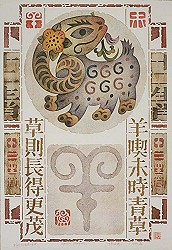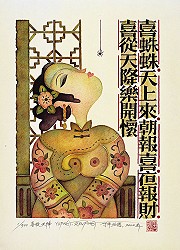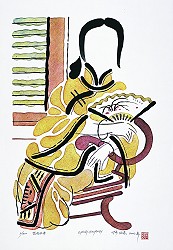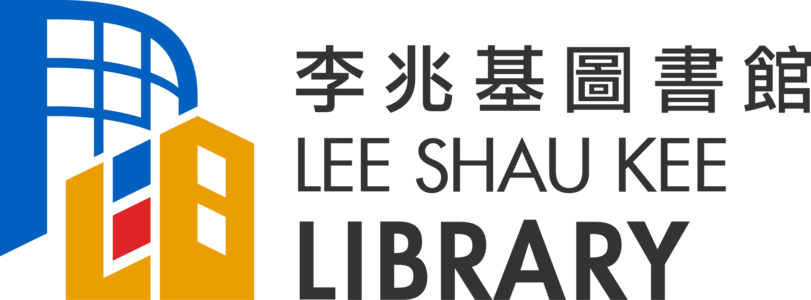
Issue No. 47
February 2003
Exhibition of Paper-Cuts & Stencil Prints
風土情 : 于平、任憑剪紙漏印版畫展
 為了迎接羊年的來臨,圖書館將舉辦一次極具鄉土趣味的展覽:于平、任憑剪紙漏印版畫展。
為了迎接羊年的來臨,圖書館將舉辦一次極具鄉土趣味的展覽:于平、任憑剪紙漏印版畫展。
中國是剪紙藝術起源最早的國家。從漢朝開始,到了南北朝時已相當精熟,而真正繁盛的時期是在清代中期以後。可以說,剪紙是中國民間流傳最廣,覆蓋面最大,地域風格變化最多的一種藝術形式。
漏印,又稱孔版漏印,是一種鏤空模版印刷方法。其特點是正刻正印,將紙皮,塑膠版,塑料布或透明膠片等鏤刻圖形製成孔版,通過多版分色漏印,形成了 色彩豐富的圖案。鏤空模版印刷術,最早見於長沙馬王堆漢墓出土的絲綢印花紗,反映出當時的印刷技術已十分精良,能用鏤空版套印製絲織品。山東一帶的民間彩 印花布至今依然沿用鏤空紙版漏印的方法,色彩斑斕,種類多樣,技術廣見於衣布、窗簾、門帘、桌圍、被面、褥面等等。
于平、任憑夫婦從事剪紙創作多年,後來接觸到山東嘉祥民間彩印花布,發現拼色剪紙與民間彩印有許多相通結合之處,於是全心轉向漏印版畫的創作。這次 展出作品一百餘件,以喜慶吉祥為主題。讀者們可以從這些作品中看到他們過去十餘年在藝術道路上的努力與成果。他們的作品技法雖取之於民間,又別於民間,在 鄉土藝術的基礎上,開創了特有的風格與形式。


COLLECTION SPOTLIGHT: New Reference Collection from Wiley
Access to five major reference works, one lab manual and an additional 190 academic journals from Wiley is now available due to the formation of a Hong Kong (JULAC) Wiley consortium. Under this new arrangement, seven participating UGC Libraries will have reciprocal access to each others’ journal subscriptions and will be able to swap some of their less-used journals to other Wiley products while at the same time benefitting from substantial discounts.
HKUST Library has now added access to five of Wiley’s major reference works: Ullmann’s Encyclopedia of Industrial Chemistry covers the complete field of processes, plants and chemicals in chemical and industrial engineering;Encyclopedia of Polymer Science & Technology includes information about polymers, plastics, biomaterials, elastomers and polymerization; Encyclopedia of Imaging Science & Technology deals with all aspects of imaging science including archaeology, life sciences, engineering and analytical chemistry; Encyclopedia of Reagents for Organic Synthesis, featuring over 48,000 reactions and 4,500 frequently consulted reagents, allows users to search by structure or sub-structure, reagent, reaction type, experimental conditions and fulltext; and Encyclopedia of Software Engineering includes over 500 entries in 35 taxonomic areas and a number of short entries defining specific terms according to the IEEE standards.
Through Wiley InterScience (http://library.hkust.edu.hk/cgi/db/wiley.pl?all), you will be able to perform cross-content searching of these reference works, Current Protocols in Molecular Biology, and the 243 Wiley journals subscribed to by the JULAC libraries. For detailed descriptions of the five NEW databases, consult the Alphabetical Database Listing at http://library.hkust.edu.hk/info/db/alpha.html
INTERNET: Learning Putonghua Online 網上學普通話
Learning Putonghua has become the hottest trend in language learning these days. According to recent surveys, the second most frequently chosen foreign language for study is Chinese, by 30 million people in 85 countries. There are excellent online tools available for local and non-local students to learn this language.
Beginners may start at Learning Chinese Online (http://www.csulb.edu/~txie/online.htm). It has an extensive collection of web sites in a variety of helpful categories. For learning and practicing Pinyin, see its various sites under pronunciation such as Chinese Pinyin (http://www.speakingchinese.com/) which provides free registration to a number of its courses. Its fundamental program is for beginners to grasp the key to Chinese pronunciation by learning its phonetic system. Under the conversation section, the site Audio Tutorial of Survival Chinese (http://www.csulb.edu/~txie/online.htm) is particularly useful for learning short conversational phrases like 祝你旅途愉快! (Wish you a happy journey!)
Intermediate learners should find the course LANG 111 (http://lc.ust.hk/~courses/111/) designed by our Language Center quite helpful. It consists of 18 lessons ranging from 認識與介紹 to 面試. Each lesson comes with the text and its sound file. Pinyin are given for its vocabularies and special terms. Learners can choose “听一次” to listen to the text or “跟讀” to read along with the recorded voice.
For learning Putonghua with fun, see 普通話A計劃 (http://www.rthk.org.hk/special/pthleague2002/aproject.htm) which broadcasts on RTHK every Sunday. The archive for all its programs is available at the site. Each program has 5 sections: “普通話知多D” “Bo Po Mo Fo讀好D” “PM教室” “開心時間” and “PM信箱”. Each section has its own format including interesting conversations, differences between Putonghua and Cantonese, listening to songs, etc. Past programs are also available.
You may also learn Putonghua by listening to online news channels. RTHK’s Putonghua Channel (http://www.rthk.org.hk/channel/pth/) covers various local programs including finance, music, current affairs, etc. Voice of America: Putonghua (http://www.voa.gov/chinese/stream-time.htm) is also an excellent channel for learning the language.
When you need to look up the meaning, pinyin, or pronunciation of various Chinese characters, the Chinese-English Dictionary of Modern Usage by Lin Yutang (http://humanum.arts.cuhk.edu.hk/Lexis/Lindict/) or Zhongwen.com (http://zhongwen.com/) should meet your needs well.
Last but not least, On-line Chinese Tools (http://www.mandarintools.com/) contains a wealth of sources for learning Putonghua including adding pinyin to any Chinese text file on your computer or any Chinese web page!
MEDIA: Fundamental Questions
As the New Years, both solar and lunar, come and go, we find ourselves with more time on our hands, time that we can use for reflection. We may ask, “Where does the universe come from?”, “What is time?”, “How did life emerge?”, “Where do humans come from?” Media Resources has some materials that attempt to answer these fundamental questions.
Cosmology The Blue planet and pale moon above (Media Resources QB43.2 .C66 1998 v.4) discusses the birth, development, and structure of the Earth, what makes it rotate, and why it tilts and has seasons. It also examines the birth of the moon and its influence on our lives.
Mysteries of the universe (Media Resources Q125 .S4346 1998 v.2) Investigate how scientists struggle to discover the laws governing life. Topics include, telescopes, pulsars, astrophysics, black holes, the atom and more.
Origin of Life Planet of life (Media Resources QH366.2 .P526 1995 v. 1-4) This four-part series explores the evolutionary development of life on Earth. Volume 1 covers the birth of earth and ancient oceans; vol. 2 discusses the evolution of dinosaurs and birds; vol. 3 shows the world of insects and also human evolution; vol. 4 speculates on what may lie in the future.
Time About time (Media Resources QB209 .A268 1995) Explores the meaning of time through the ages and the development of time-measuring and time-keeping instruments.
Mirrors of time (Media Resources CE6 .M57 1990) Using computer animation, it looks at the history of the measurement of time. It discusses how our calendar came to be, why the seasons change, how the days of the week got their names and why the year is divided into days, weeks and months.
Human Evolution Ape Man: Adventures in Human Evolution (Media Resources GN281 .A635 2001 ep. 1-6) This VCD series guides you through the past 5 million years of human evolution. There is an accompanying web site as well: http://www.bbc.co.uk/science/apeman/
To find more on answers to such questions, set the Webpac subset to Media, and do subject searches on “Cosmology”, “Life – Origin”, or “Human beings – Origin”.
INFORMATION SERVICES: SciTech Alert and LibTalk
The Library launched two new services in November: SciTech Alert and LibTalk.
SciTech Alert highlights new and interesting books and articles on general science and technology topics. Each release features two articles from the latest issues of popular science magazines, as well as one book from among the Library’s new arrivals. Selected science news stories are also included. The service is distributed via the information list “HKUST Library SciTech Alert” on the first and third Wednesday of each month.
Initially planned to raise the awareness of undergraduates to current issues in science and technology, the books and articles selected will be of interest to many in the University community. You may see past issues at http://library.hkust.edu.hk/scitech/. To join the list, just send a request to lbmail@ust.hk, or follow these steps:
- Go to https://lists.ust.hk/cgi-bin/itsc/mailinglist/restricted/subscribe.pl
- Choose “Library-SciTech-ALERT-list” in the “Information Mailing List” group.
- Choose “Subscribe”, and then “Submit”.
LibTalk (網上讀書室) is a collaboration between the Library and the People’s Campus Radio (http://home.ust.hk/campusradio/), the University’s WWW radio station. In this series of radio programs we introduce useful and interesting sources available in the Library and on the Web. Each episode covers one specific topic, which may be fun, practical, or educational. The first two programs, broadcast in Cantonese, discussed Hong Kong hiking trails and stress relief.
People’s Campus Radio broadcasts LibTalk during academic terms on the second and the fourth Thursday of each month at 9 p.m. Transcripts and sound files are available at http://library.hkust.edu.hk/info/libtalk/.
Wanted: A Comprehensive Calendar of Events
Our campus needs a comprehensive online calendar of events. We have been here for more than eleven years, and we still do not have one.
The Office of University Development and Public Affairs has recently finished a complete revamp of the UST Web Site, including the addition of a new events calendar (http://www.ust.hk/en/cgi-bin/pb0001.pl). But many events are not on it!
The key word to keep in mind is COMPREHENSIVE. If there is an event on campus, it should be listed there – regardless of its organizers, target audience, or type of function. Seminars, conferences, sport activities, exhibitions, parties… EVERYTHING.
Why are lectures organized by individual departments not listed? Why are activities arranged by student societies not listed? Why are events set up for individual classes, but open to the public, not listed?
If you are organizing any activity on campus, you should be complaining. If you want to attend any activity on campus, you should be complaining. Lobby for change!
Certainly the details are tricky – who will input the information, when, what about updates? Perhaps all IDLPs should be tasked with entering their departmental functions. Perhaps ARR should make such a listing a requirement for room bookings. Perhaps SAO can coordinate entry of Student activities. Perhaps you will have a better idea?
It does not have to be perfect. Let’s get started NOW, and improve as we go along. The interest is there, the tools exist; what we need now is motivation and direction.
last modified 28 January 2003

